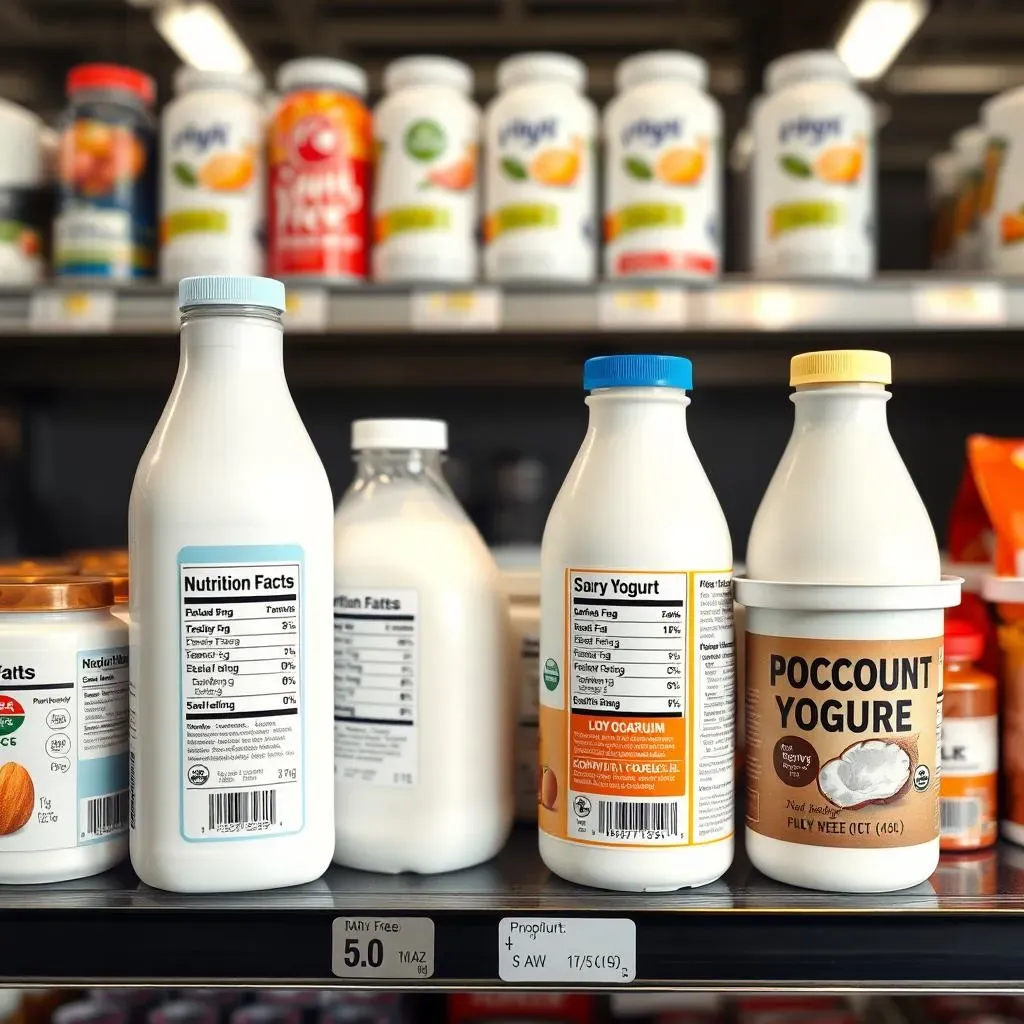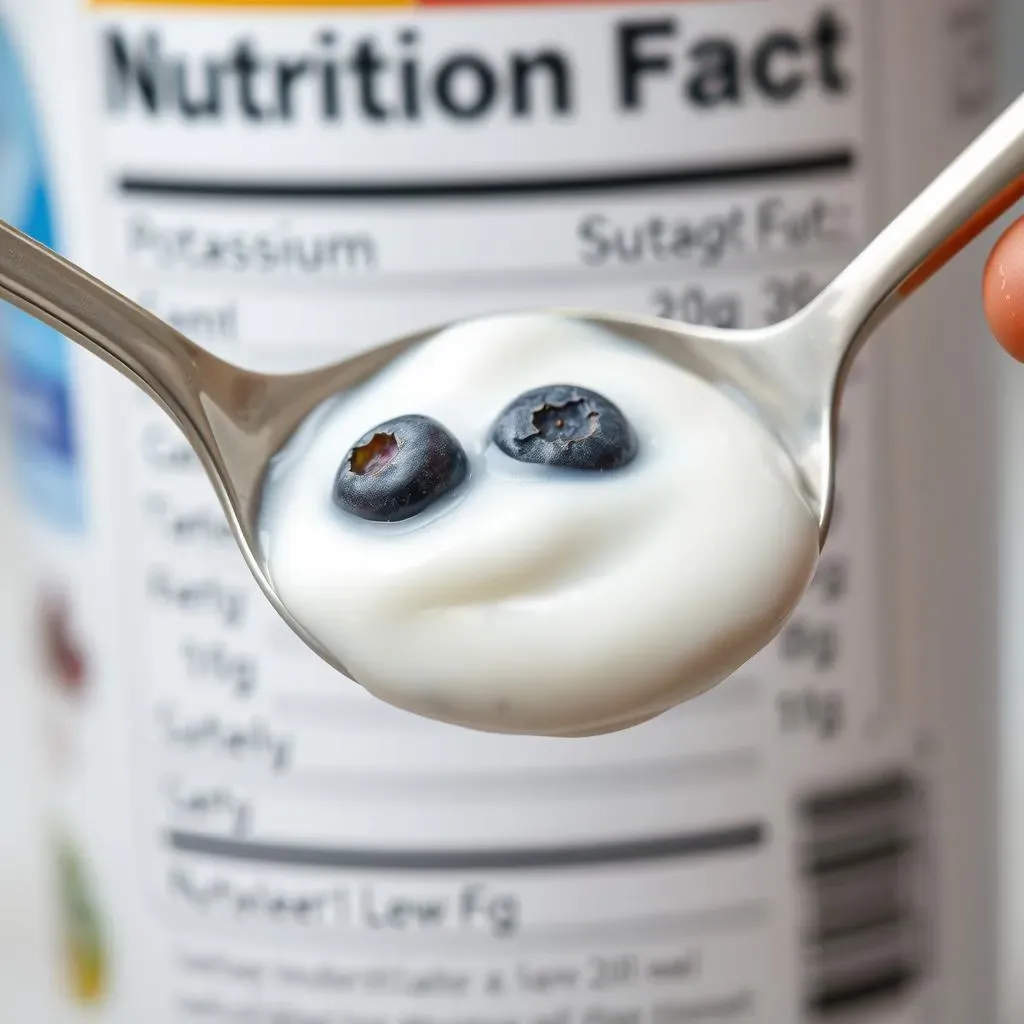Table of Contents
If you're keeping an eye on your potassium and phosphorus intake, especially due to chronic kidney disease (CKD), dairy products can be a bit of a minefield. Dairy is naturally rich in these minerals, which can be problematic if your kidneys aren't functioning at their best. But don't worry, that doesn't mean you have to ditch dairy altogether. This article dives into the world of dairy alternatives, focusing specifically on how to navigate the potassium content of low fat yogurt and other options. We'll explore which choices are kinder to your kidneys, highlighting the importance of reading labels, understanding serving sizes, and making informed decisions about what you eat. Is low fat yogurt potassium content something to be concerned about? Let's find out, and discover some tasty and healthy alternatives along the way. Plus, we'll touch on why consulting with a healthcare professional is always the best strategy for personalized dietary advice.
Understanding Potassium and Phosphorus in Dairy

Understanding Potassium and Phosphorus in Dairy
so you're diving into potassium and phosphorus in dairy – good for you! It's a crucial area, especially when folks are managing kidney health. Dairy products are naturally packed with both potassium and phosphorus, essential minerals that play key roles in various bodily functions. Potassium helps regulate blood pressure, muscle contractions, and nerve signals, while phosphorus is vital for bone health, energy production, and cell repair. However, when kidneys aren't working efficiently, these minerals can build up in the blood, leading to potential health complications. That's where understanding the levels in different dairy items becomes super important.
Think of it this way: for someone with healthy kidneys, dairy's potassium and phosphorus are generally a-okay. But if those kidneys are struggling, it's like trying to pour too much water into a glass that's already full. Excess potassium can lead to hyperkalemia, causing muscle weakness and heart problems, while too much phosphorus can contribute to bone disease and cardiovascular issues. So, knowing the specific amounts in your yogurt, milk, and cheese can make a huge difference in managing your overall health.
Navigating this gets easier when you know what to look for. Not all dairy is created equal. Some types, like certain yogurts or cheeses, might have significantly higher levels than others. And that's what we're going to break down next, so you can make smarter choices for your diet.
Low Fat Yogurt Potassium Content: What to Know

Low Fat Yogurt Potassium Content: What to Know
Understanding the Numbers: Potassium in Low Fat Yogurt
So, you're wondering about low fat yogurt potassium content? Let's break it down. Generally, a 6-ounce serving of plain, low-fat yogurt packs around 350-450 milligrams of potassium. That's a decent chunk of your daily recommended intake, which hovers around 4,700 milligrams for adults. Now, before you panic, remember that this is just a general guideline. The exact amount can vary depending on the brand, how the yogurt is processed, and any added ingredients. For example, Greek yogurt, known for its thicker texture and higher protein content, often contains less potassium than regular yogurt because some of the whey (which contains potassium) is removed during straining.
It's also worth noting that flavored yogurts might have different potassium levels due to the addition of fruits, sweeteners, or other flavorings. Some fruits, like bananas and berries, are naturally high in potassium, which can bump up the overall content. Always, always check that nutrition label! It's your best friend in this potassium-conscious journey.
Greek vs. Regular: A Potassium Showdown
let's get into the specifics of Greek versus regular low fat yogurt. As mentioned earlier, Greek yogurt typically has less potassium. This is due to the straining process that removes whey, reducing both lactose and potassium. A 6-ounce serving of Greek yogurt might have around 200-250 milligrams of potassium, significantly lower than regular yogurt. This makes Greek yogurt a potentially better choice if you're watching your potassium intake closely. However, don't assume all Greek yogurts are created equal. Again, that label is key!
Beyond potassium, it's also important to consider the other nutritional benefits. Greek yogurt generally has more protein and less sugar than regular yogurt, making it a satisfying and healthy option overall. Protein helps you feel fuller for longer, which can aid in weight management. Less sugar is always a win, especially if you're trying to keep your blood sugar levels stable.
Yogurt Type | Potassium (per 6 oz serving, approx.) | Protein (per 6 oz serving, approx.) | Sugar (per 6 oz serving, approx.) |
|---|---|---|---|
Low Fat Yogurt (Regular) | 350-450 mg | 5-7 grams | 10-15 grams |
Low Fat Greek Yogurt | 200-250 mg | 15-20 grams | 5-10 grams |
Reading Labels: Your Potassium Detective Kit
Alright, time to become a potassium detective! Reading nutrition labels is crucial for managing your potassium intake. Here's what to look for: First, find the "Potassium" listing on the label. It's usually expressed in milligrams (mg) per serving. Pay attention to the serving size listed at the top of the label. Is it a realistic amount for you? If you typically eat more than the listed serving size, you'll need to adjust the potassium amount accordingly. For example, if the label says 200mg of potassium per 6 ounces and you eat 12 ounces, you're actually consuming 400mg.
Next, consider the "% Daily Value" (%DV) for potassium. This tells you what percentage of the daily recommended intake you're getting from one serving. Remember, the daily value is based on a 2,000-calorie diet, so your individual needs may vary. If you're trying to limit potassium, aim for foods with a lower %DV. Also, scrutinize the ingredient list for any added potassium-containing ingredients, such as potassium chloride, which is sometimes used as a salt substitute.
Don't just focus on potassium! Look at the other nutrients as well, like phosphorus, sodium, and sugar. A balanced approach is always best. Choosing a yogurt that's low in potassium, sodium, and sugar, while still providing a good source of protein and calcium, is the ideal scenario.
Dairy Alternatives: A Low Potassium and Phosphorus Option?

Dairy Alternatives: A Low Potassium and Phosphorus Option?
Exploring Milk Alternatives for Lower Potassium
so you're looking at dairy alternatives to dodge some potassium and phosphorus? Smart move! Cow's milk can be a sneaky source of these minerals, and thankfully, there's a whole universe of plant-based milks out there. Almond milk, rice milk, and soy milk are the usual suspects, and they're generally much lower in potassium and phosphorus compared to cow's milk. For instance, a cup of cow's milk can have around 350-400mg of potassium, while a cup of almond milk might only have 50-60mg. Big difference, right?
But here's the catch: not all plant-based milks are created equal. Some brands might add potassium phosphate as a stabilizer, which kind of defeats the purpose. That's why, you guessed it, reading labels is non-negotiable. Look for unsweetened varieties to keep the sugar content down, and check for added vitamins and minerals like calcium and vitamin D, which are naturally found in cow's milk.
Dairy-Free Yogurt Options: Weighing the Pros and Cons
Now, let's talk yogurt. Finding dairy-free yogurt that's low in potassium and phosphorus can be a bit trickier. Soy yogurt is a popular choice, but the potassium and phosphorus content can vary wildly depending on the brand and how it's made. Some soy yogurts might be surprisingly high in these minerals, while others are relatively low. Coconut yogurt is another option, but it's often higher in fat and lower in protein than soy yogurt.
Again, the label is your guide. Look for yogurts that specifically list their potassium and phosphorus content. If you can't find that information, it might be best to steer clear, especially if you're on a strict kidney diet. Consider making your own dairy-free yogurt at home. This gives you complete control over the ingredients and allows you to use low-potassium milk alternatives as a base. There are tons of recipes online, and it's surprisingly easy to do!
Yogurt Alternative | Potassium (per serving, approx.) | Phosphorus (per serving, approx.) | Considerations |
|---|---|---|---|
Soy Yogurt | Varies widely, check label | Varies widely, check label | Protein content varies, may have added sugar |
Coconut Yogurt | Lower than soy yogurt | Lower than soy yogurt | Higher in fat, lower in protein |
Almond Yogurt | Generally low | Generally low | Often lower in protein and calcium |
Cheese Alternatives: A Sodium Consideration
What about cheese, you ask? Dairy-free cheese alternatives are becoming more common, but they often come with a catch: sodium. While they might be lower in potassium and phosphorus than traditional cheese, many brands load up on sodium to compensate for the lack of flavor. This can be a problem if you're also watching your sodium intake, which is often the case for people with kidney issues.
Look for low-sodium cheese alternatives, and be prepared to experiment with different brands to find one that you like. Nutritional yeast can also be used to add a cheesy flavor to dishes without the added potassium, phosphorus, or sodium. It's a staple in many vegan kitchens and a great way to boost the umami factor in your meals. Ultimately, dairy alternatives can be a helpful tool for managing potassium and phosphorus, but they're not a magic bullet. Careful planning, label reading, and a balanced approach are essential for success.
Comparing Potassium Levels: Low Fat Yogurt vs. Alternatives

Comparing Potassium Levels: Low Fat Yogurt vs. Alternatives
The Potassium Scorecard: Yogurt vs. Milk Alternatives
Alright, let's get down to brass tacks and compare the potassium levels in low fat yogurt versus some popular dairy alternatives. As we've discussed, a 6-ounce serving of plain low fat yogurt typically contains around 350-450mg of potassium. Greek yogurt, thanks to its straining process, usually clocks in lower, around 200-250mg. Now, let's see how these numbers stack up against the competition. Almond milk generally has a very low potassium content, often around 50-60mg per cup. Rice milk is similar, usually hovering in the 20-30mg range. Soy milk can vary a bit more, but it's generally still lower than cow's milk, typically containing around 250-300mg per cup. These figures highlight a clear advantage for many milk alternatives when it comes to potassium management.
However, it's not just about the numbers. The overall nutritional profile matters too. While almond and rice milk are low in potassium, they might also be lower in protein and other essential nutrients compared to yogurt. Soy milk offers a better protein balance, but it's crucial to check for added sugars or potassium phosphate. Remember, the goal is to find a balance that meets your individual needs and preferences while keeping potassium levels in check.
Food Item (per serving) | Potassium Content (approx.) |
|---|---|
Low Fat Yogurt (6 oz) | 350-450 mg |
Low Fat Greek Yogurt (6 oz) | 200-250 mg |
Almond Milk (1 cup) | 50-60 mg |
Rice Milk (1 cup) | 20-30 mg |
Soy Milk (1 cup) | 250-300 mg |
Practical Implications: Making the Right Choice for You
So, what does all this mean for your daily diet? Well, if you're closely monitoring your potassium intake, swapping out regular low fat yogurt for Greek yogurt or a plant-based milk alternative could be a smart move. For example, if you typically start your day with a cup of yogurt, switching to almond milk could save you around 300-400mg of potassium. That can add up over time! But remember, it's not just about cutting back on potassium. You also need to make sure you're getting enough protein, calcium, and other essential nutrients. If you're switching to almond milk, consider adding a protein source to your breakfast, like nuts or seeds. Or, choose a fortified almond milk that's been enriched with calcium and vitamin D.
Ultimately, the best choice depends on your individual needs and preferences. Some people might find that they can still enjoy low fat yogurt in moderation, as long as they balance it out with other low-potassium foods throughout the day. Others might prefer to stick to plant-based alternatives to minimize their potassium intake as much as possible. The key is to be informed, be mindful, and listen to your body. And, of course, consult with your doctor or a registered dietitian to create a personalized meal plan that works for you.
Making Informed Choices: Reading Labels and Consulting Professionals

Making Informed Choices: Reading Labels and Consulting Professionals
Decoding the Fine Print: Mastering the Nutrition Label
so you're ready to become a nutrition label ninja? Awesome! This is where the rubber meets the road when it comes to managing your potassium and phosphorus intake. We've already touched on this, but it's worth diving deeper. The nutrition label is your key to unlocking the secrets of any food product. Start by zeroing in on the serving size. Is it realistic? Manufacturers often use smaller serving sizes to make the numbers look better, so be honest with yourself about how much you actually eat.
Next, find the potassium and phosphorus listings. These are usually expressed in milligrams (mg) per serving. Pay close attention to the % Daily Value (%DV) as well. This tells you how much of the recommended daily intake you're getting from one serving. Remember, the %DV is based on a 2,000-calorie diet, so your individual needs may vary. Also, scrutinize the ingredient list for hidden sources of potassium and phosphorus, like potassium chloride or phosphate additives. The more you practice, the easier it will become to spot these sneaky ingredients!
When in Doubt, Reach Out: The Value of Professional Guidance
Look, I get it. Navigating the world of nutrition can be confusing and overwhelming, especially when you're dealing with specific health concerns like kidney disease. That's where a registered dietitian (RD) or your doctor comes in. These professionals can provide personalized guidance tailored to your individual needs and medical history. They can help you create a meal plan that's both nutritious and kidney-friendly, taking into account your potassium and phosphorus levels, as well as any other dietary restrictions or concerns you might have.
Think of it this way: you wouldn't try to fix your car without a mechanic, right? Similarly, when it comes to your health, it's always best to seek expert advice. An RD can help you decipher those confusing nutrition labels, identify hidden sources of potassium and phosphorus, and develop strategies for managing your intake without sacrificing flavor or enjoyment. Plus, they can provide ongoing support and motivation to help you stay on track. Don't be afraid to reach out – your health is worth it!
Professional | Expertise | Benefits |
|---|---|---|
Registered Dietitian (RD) | Nutrition and dietary planning | Personalized meal plans, label reading guidance, ongoing support |
Doctor | Medical management and overall health | Medical advice, monitoring kidney function, medication management |
Making Smart Choices for Your Health
Navigating the world of dairy and dairy alternatives when you're mindful of potassium and phosphorus can feel like a challenge, but it doesn't have to be overwhelming. Remember, knowledge is power. By understanding the potassium content in low fat yogurt and exploring alternatives like almond, rice, or soy milk, you can make informed dietary choices that support your health goals. Always prioritize reading nutrition labels to keep track of phosphorus, potassium, and sodium levels. And most importantly, work closely with your doctor or a registered dietitian to create a personalized eating plan that meets your unique needs. With the right information and guidance, you can enjoy a balanced diet while effectively managing your kidney health.
